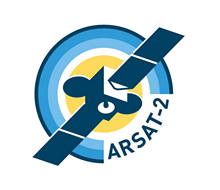 ARSAT-2 in INVAP. | |
| Mission type | Communication |
|---|---|
| Operator | ARSAT |
| COSPAR ID | 2015-054B [1] |
| SATCAT no. | 40941 [1] |
| Mission duration | 15 years |
| Spacecraft properties | |
| Spacecraft | ARSAT-2 |
| Bus | ARSAT-3K [2] |
| Manufacturer | INVAP Thales Alenia Space |
| Launch mass | 2,977 kilograms (6,563 lb) [3] |
| Power | 4,600 W [4] |
| Start of mission | |
| Launch date | 20:30,September 30, 2015(UTC) [5] |
| Rocket | Ariane 5ECA |
| Launch site | Kourou ELA-3 |
| Contractor | Arianespace |
| Orbital parameters | |
| Reference system | Geocentric |
| Regime | Geostationary |
| Longitude | 81° West |
| Transponders | |
| Band | 20 (24 36 MHz equivalent) IEEE Ku band and 6 (13 36 MHz equivalent) IEEE C band transponders [2] |
| Frequency | Ku band and C band |
| Bandwidth | Ku band: 864 MHz C band: 464 MHz |
| Coverage area | North and South America |
 ARSAT-2 Mission Logo ARSAT Satellite Fleet | |
ARSAT-2 is a geostationary communications satellite operated by ARSAT and built by the Argentine company INVAP. [6] It was launched from French Guiana alongside Sky Muster satellite using an Ariane 5ECA rocket on September 30, 2015 at 20:30hs UTC, becoming the 400th satellite to be launched by Arianespace. [7] [8] It is licensed to be located at 81° West longitude geostationary slot. [9] [10] ARSAT-2 is the second geostationary satellite built in Argentina, after ARSAT-1. Structurally and mechanically it is a copy of the ARSAT-1, the only difference being the payload and thus it has different antenna configuration. [11] [2]